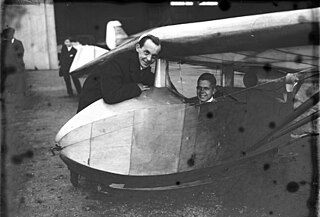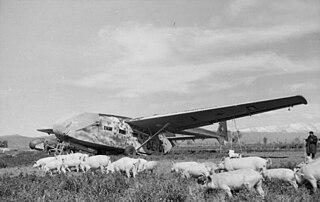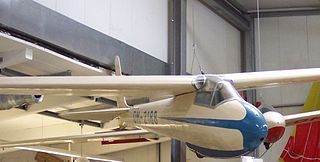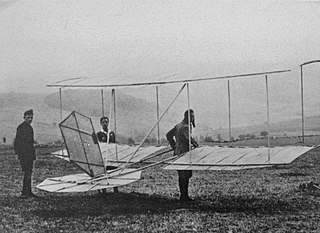Related Research Articles

Alexander Martin Lippisch was a German aeronautical engineer, a pioneer of aerodynamics who made important contributions to the understanding of tailless aircraft, delta wings and the ground effect, and also worked in the U.S. Within the Opel-RAK program, he was the designer of the world's first rocket-powered glider.

The DFS 230 was a German transport glider operated by the Luftwaffe in World War II. It was developed in 1933 by the Deutsche Forschungsanstalt für Segelflug with Hans Jacobs as the head designer. The glider was the German inspiration for the British Hotspur glider and was intended for airborne assault operations.

The DFS 228 was a rocket-powered, high-altitude reconnaissance aircraft designed by the Deutsche Forschungsanstalt für Segelflug during World War II. By the end of the war, the aircraft had only flown in the form of two unpowered prototypes.

The DFS 346 was a German rocket-powered swept-wing aircraft which began development during World War II in Germany. It was designed by Felix Kracht at the Deutsche Forschungsanstalt für Segelflug (DFS), the "German Institute for Sailplane Flight". A prototype was constructed but did not reach completion before the end of the war. It was taken to the Soviet Union where it was completed, tested and flown.

The Gotha Go 242 was a transport glider used by the Luftwaffe during World War II. It was an upgrade over the DFS 230 in both cargo/troop capacity and flight characteristics. It saw limited combat action. There were multiple variants.

The DFS Olympia Meise was a German sailplane designed by the Deutsche Forschungsanstalt für Segelflug (DFS) for Olympic competition, based on the DFS Meise.
The Rhön-Rossitten Gesellschaft (RRG) or Rhön-Rossitten Society was a German gliding organization, the first one in the world that was officially recognised. The Rhön-Rossitten Gesellschaft was mainly responsible for establishing gliding as a sport, not only in Germany but eventually throughout the world.
Contrary to the methods used by the Reich Air Ministry (RLM) for the allocation of aircraft designations, the designers and manufacturers of sailplanes and gliders in Germany enjoyed the freedom of choosing their own designations for their products up until 1945.

The DFS 331 was a transport glider prototype developed in a collaboration between DFS and Gotha. It was a twenty-seat troop transport designed by Hans Jacobs, who had previously produced the successful, nine seat DFS 230.

Roger Béteille was a French aeronautical engineer and businessman. Regarded as one of the founding fathers of the company, he is known for his contributions towards Airbus, which contributed towards the airline company's initial success. He also worked for Air France, Lufthansa, United, TWA and American Airlines.

Flugwissenschaftliche Vereinigung Aachen is a non-profit organization, founded in 1920, which is closely associated to RWTH Aachen University, with members consisting of RWTH Aachen students, which have included Felix Kracht. FVA supports and organizes various training courses for flight training, handling of composites and other aircraft materials including steel and aluminum.

Dr. Wolfgang Benjamin Klemperer was born in Dresden, Germany, the son of the Austrian nationals Leon and Charlotte Klemperer. He was in his time a prominent aviation and aerospace scientist and engineer, who ranks among the pioneers of early aviation.
Heini Dittmar was a record-breaking German glider pilot.

The Eon Olympia was a glider produced from 1947 by Elliotts of Newbury.

The Pelzner Hang Glider was a simple, lightweight, low cost but strong hang glider built in Germany in 1920, intended to make flying accessible to large numbers of young people. Variants competed with some success in the first two Rhön contests held on the Wasserkuppe.
The FVA 1 Schwatze Düvel was a glider produced in Germany in 1920. It was a highly streamlined, thick winged cantilever monoplane.

The DFS Kranich is a type of German glider. It was developed by Hans Jacobs for the Deutsche Forschungsanstalt für Segelflug (DFS).

The DFS Weihe is a German single-seat, high-wing, 18 metre wingspan, high-performance glider that was designed by Hans Jacobs in 1937-38.
The DFS 230F was a military assault glider designed and built in Germany, by Gotha during World War II, to succeed the smaller DFS 230 which it was only related to by name.
References
- ↑ "Gold class: Airbus is flying high at 50". The West Australian. 31 May 2019.